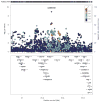A genome-wide association study for coronary artery disease identifies a novel susceptibility locus in the major histocompatibility complex
- PMID: 22319020
- PMCID: PMC3335297
- DOI: 10.1161/CIRCGENETICS.111.961243
A genome-wide association study for coronary artery disease identifies a novel susceptibility locus in the major histocompatibility complex
Abstract
Background: Recent genome-wide association studies (GWAS) have identified several novel loci that reproducibly associate with coronary artery disease (CAD) and/or myocardial infarction risk. However, known common CAD risk variants explain only 10% of the predicted genetic heritability of the disease, suggesting that important genetic signals remain to be discovered.
Methods and results: We performed a discovery meta-analysis of 5 GWAS involving 13 949 subjects (7123 cases, 6826 control subjects) imputed at approximately 5 million single nucleotide polymorphisms, using pilot 1000 Genomes-based haplotypes. Promising loci were followed up in an additional 5 studies with 11 032 subjects (5211 cases, 5821 control subjects). A novel CAD locus on chromosome 6p21.3 in the major histocompatibility complex (MHC) between HCG27 and HLA-C was identified and achieved genome-wide significance in the combined analysis (rs3869109; p(discovery)=3.3×10(-7), p(replication)=5.3×10(-4)p(combined)=1.12×10(-9)). A subanalysis combining discovery GWAS showed an attenuation of significance when stringent corrections for European population structure were used (P=4.1×10(-10) versus 3.2×10(-7)), suggesting that the observed signal is partly confounded due to population stratification. This gene dense region plays an important role in inflammation, immunity, and self-cell recognition. To determine whether the underlying association was driven by MHC class I alleles, we statistically imputed common HLA alleles into the discovery subjects; however, no single common HLA type contributed significantly or fully explained the observed association.
Conclusions: We have identified a novel locus in the MHC associated with CAD. MHC genes regulate inflammation and T-cell responses that contribute importantly to the initiation and propagation of atherosclerosis. Further laboratory studies will be required to understand the biological basis of this association and identify the causative allele(s).
Conflict of interest statement
Figures




References
-
- Lloyd-Jones DM, Nam BH, D’Agostino RB, Sr, Levy D, Murabito JM, Wang TJ, et al. Parental cardiovascular disease as a risk factor for cardiovascular disease in middle-aged adults: a prospective study of parents and offspring. JAMA. 2004;291:2204–11. - PubMed
-
- Helgadottir A, Thorleifsson G, Manolescu A, Gretarsdottir S, Blondal T, Jonasdottir A, et al. A common variant on chromosome 9p21 affects the risk of myocardial infarction. Science. 2007;316:1491–1493. - PubMed
-
- Reilly MP, Li M, He J, Ferguson JF, Stylianou IM, Mehta NN, et al. Identification of ADAMTS7 as a novel locus for coronary atherosclerosis and association of ABO with myocardial infarction in the presence of coronary atherosclerosis: two genome-wide association studies. Lancet. 2011;377:383–392. - PMC - PubMed
Publication types
MeSH terms
Substances
Grants and funding
- UL1 RR024989/RR/NCRR NIH HHS/United States
- R01-HL095987/HL/NHLBI NIH HHS/United States
- 1RC2-HL101612-01/HL/NHLBI NIH HHS/United States
- R01 HL103931/HL/NHLBI NIH HHS/United States
- R01 HL103866/HL/NHLBI NIH HHS/United States
- 1UL1RR024989/RR/NCRR NIH HHS/United States
- R01 DK080732/DK/NIDDK NIH HHS/United States
- P01 HL098055/HL/NHLBI NIH HHS/United States
- CH/03/001/15569/BHF_/British Heart Foundation/United Kingdom
- MOP82810/CAPMC/ CIHR/Canada
- R01 HL095987/HL/NHLBI NIH HHS/United States
- P01 HL076491/HL/NHLBI NIH HHS/United States
- 076113/WT_/Wellcome Trust/United Kingdom
- RC2 HL101621/HL/NHLBI NIH HHS/United States
- MOP77682/CAPMC/ CIHR/Canada
- 085475/WT_/Wellcome Trust/United Kingdom
- WT_/Wellcome Trust/United Kingdom
LinkOut - more resources
Full Text Sources
Medical
Research Materials
Miscellaneous

